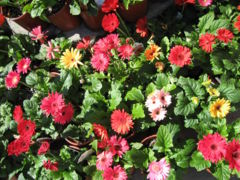Gerbera: Difference between revisions
No edit summary |
No edit summary |
||
| Line 33: | Line 33: | ||
{{Inc| | {{Inc| | ||
Gerbera (named in honor of Traug. Gerber, a German naturalist who traveled in Russia). | Gerbera (named in honor of Traug. Gerber, a German naturalist who traveled in Russia). Compositae. A small group of temperate and tropical Asiatic and African perennial herbs grown for their yellow or pink or orange flower-heads. | ||
Stemless herbs with radical, petioled | Stemless herbs with radical, petioled leaves which are entire or sometimes lobed: flower-heads solitary, many-flowered, the conspicuous rays in 1 or 2 rows, those of the inner row, when present, very short and sometimes tubular and 2-lipped, as are the disk-flowers.: achenes beaked.— There are 40 species, only one of which (G. jamesonii) is well known in Amer. and is sometimes found outside the collections of botanic gardens and fanciers. They should be grown in the temperate house, in a rich compost of sandy loam and peat. Propagation by seeds or by cuttings of side shoots. | ||
G. aurantiaca, Sch. A handsome plant with | G. aurantiaca, Sch. A handsome plant with flowers 2 ½ inches diameter: florets red. with bright yellow anthers. Natal and the Transvaal. Has been listed under name of G. elsae. | ||
—G. cantabrigiensis, Hort. A garden hybrid between G. jamesonii and G. viridifolia. | |||
—G. viridifolia, Sch., is a little-known green-leaved plant with showy flowers that are white on the upper side, yellow beneath. S. Afr.—Well worth growing in temperate house. | |||
{{SCH}} | {{SCH}} | ||
}} | }} | ||
Revision as of 05:20, 9 May 2010
Gerbera {{{latin_name}}}
|
Gerbera, Transvaal daisy, Barberton Daisy
| ||||||||||||||||||||||||||||||||||||||||
|---|---|---|---|---|---|---|---|---|---|---|---|---|---|---|---|---|---|---|---|---|---|---|---|---|---|---|---|---|---|---|---|---|---|---|---|---|---|---|---|---|---|

|
|
| |||||||||||||||||||||||||||||||||||||||
| |||||||||||||||||||||||||||||||||||||||||
Hairy, stemless herbs. Perennials which can be treated like annualsRH. Leaves may spread or come up from a basal rosette, are entire to dentate (or rarely pinnately lobed), petiolate, and hairy underneathRH.
| Standard Cyclopedia of Horticulture |
|---|
|
Gerbera (named in honor of Traug. Gerber, a German naturalist who traveled in Russia). Compositae. A small group of temperate and tropical Asiatic and African perennial herbs grown for their yellow or pink or orange flower-heads. Stemless herbs with radical, petioled leaves which are entire or sometimes lobed: flower-heads solitary, many-flowered, the conspicuous rays in 1 or 2 rows, those of the inner row, when present, very short and sometimes tubular and 2-lipped, as are the disk-flowers.: achenes beaked.— There are 40 species, only one of which (G. jamesonii) is well known in Amer. and is sometimes found outside the collections of botanic gardens and fanciers. They should be grown in the temperate house, in a rich compost of sandy loam and peat. Propagation by seeds or by cuttings of side shoots. G. aurantiaca, Sch. A handsome plant with flowers 2 ½ inches diameter: florets red. with bright yellow anthers. Natal and the Transvaal. Has been listed under name of G. elsae. —G. cantabrigiensis, Hort. A garden hybrid between G. jamesonii and G. viridifolia. —G. viridifolia, Sch., is a little-known green-leaved plant with showy flowers that are white on the upper side, yellow beneath. S. Afr.—Well worth growing in temperate house. CH
|
Cultivation
Most common are the G. jamesonii hybrids, with extremely long-lasting cut flowersRH. The flowers come in a wide range of pastel and basic bright colors. In frost-free areas they overwinter safely outdoorsRH. In cold-winter areas, keep at 5-7°C (40-45°F) and keep just moistRH.
Tip: Scald tip of stem when cutting flowers for vase to make them last longerRH.
Propagation
Plants may be divided in the springRH. Seed.
Pests and diseases
- Do you have pest and disease info on this plant? Edit this section!
Species
About 40 speciesRH, includingwp:
- Gerbera aberdarica
- Gerbera abyssinica
- Gerbera ambigua
- Gerbera anandria : Ghostly Daisy
- Gerbera anandria var. anandria
- Gerbera anandria var. densiloba
- Gerbera anandria var. integripetala
- Gerberia anadria var. bonatiana
- Gerbera aspleniifolia
- Gerbera aurantiaca : Hilton Daisy
- Gerbera bojeri
- Gerbera bonatiana
- Gerbera bracteata
- Gerbera brevipes
- Gerbera burchellii
- Gerbera burmanni
- Gerbera candollei
- Gerbera cavaleriei
- Gerbera chilensis
- Gerbera cineraria
- Gerbera connata
- Gerbera conrathii
- Gerbera cordata
- Gerbera coronopifolia
- Gerbera curvisquama
- Gerbera delavayi
- Gerbera discolor
- Gerbera diversifolia
- Gerbera elegans
- Gerbera elliptica
- Gerbera emirnensis
- Gerbera ferruginea
- Gerbera flava
- Gerbera galpinii
- Gerbera glandulosa
- Gerbera henryi
- Gerbera hieracioides
- Gerbera hirsuta
- Gerbera hypochaeridoides
- Gerbera integralis
- Gerbera integripetala
- Gerbera jamesonii : Barberton Daisy, Gerbera Daisy, Transvaal Daisy
- Gerbera knorringiana
- Gerbera kokanica
- Gerbera kraussii
- Gerbera kunzeana
- Gerbera lacei
- Gerbera lagascae
- Gerbera lanuginosa
- Gerbera lasiopus
- Gerbera latiligulata
- Gerbera leandrii
- Gerbera leiocarpa
- Gerbera leucothrix
- Gerbera lijiangensis
- Gerbera lynchii
- Gerbera macrocephala
- Gerbera nepalensis
- Gerbera nervosa
- Gerbera nivea
- Gerbera parva
- Gerbera peregrina
- Gerbera perrieri
- Gerbera petasitifolia
- Gerbera piloselloides
- Gerbera plantaginea
- Gerbera plicata
- Gerbera podophylla
- Gerbera pterodonta
- Gerbera pulvinata
- Gerbera pumila
- Gerbera randii
- Gerbera raphanifolia
- Gerbera ruficoma
- Gerbera saxatilis
- Gerbera semifloscularis
- Gerbera serotina
- Gerbera speciosa
- Gerbera tanantii
- Gerbera tomentosa
- Gerbera tuberosa
- Gerbera uncinata
- Gerbera viridifolia
- Gerbera welwitschii
- Gerbera wrightii
Gallery
If you have a photo of this plant, please upload it! Plus, there may be other photos available for you to add.
-
photo 1
-
photo 2
-
photo 3
References
External links
- w:Gerbera. Some of the material on this page may be from Wikipedia, under the Creative Commons license.
- Gerbera QR Code (Size 50, 100, 200, 500)
